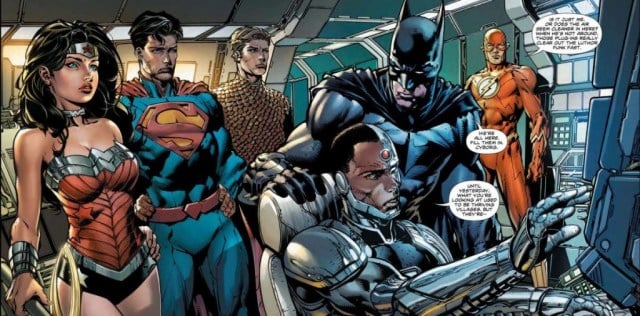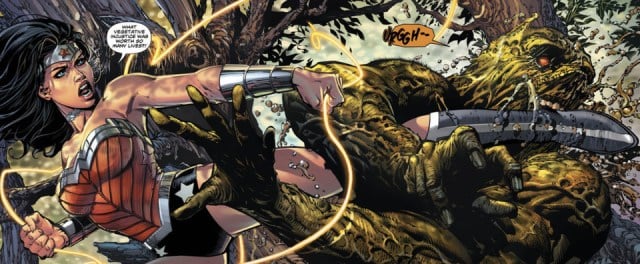The following was originally written for DoomRocket, and has been republished here with permission.
As someone who has read Wonder Woman for as long as I have (since I began reading comics, in fact), I can very much understand that certain nerdy compulsion to follow a character’s comic book despite whatever creative team may be at the helm. For over a decade, DC has (mostly) made sure to keep Wonder Woman under the guidance of A-list talent. In the decade I’ve been reading, Phil Jimenez, Greg Rucka, Allan Heinberg, Adam Hughes, Gail Simone, Terry and Rachel Dodson, and most recently Brian Azzarello and Cliff Chiang (two well-noted favorites of mine) have all created stand-out stories of the Amazon Princess, and did a fantastic job in continuing to challenge and redefine the character. Because of this, for a long, long time I’ve been able to rely on each successive issue of Wonder Woman to be an enjoyable read. But, as even a demi-god must learn, all things must come to an end.
Azzarello and Chiang finished off their thirty-five issue run – one of the longest in DC’s New 52 so far – as cleanly and elegantly as possible, leaving plenty of open room so that the next creative team could freely move around. That team was announced in June with artist David Finch and his wife, writer Meredith Finch taking creative reins. And while I wanted to be hopeful that one of my favorite characters might continue to have a story worth reading, the Finches’ gaffes in initial promotional interviews threw up some red flags. Remarks from David included “…we want her to be a strong – I don’t want to say feminist, but a strong character. Beautiful, but strong…” and, “…I’m really very visually attracted to Wonder Woman. She just looks great on the page.” And from Meredith, we got “…women tend to react in a different way, and I can bring some of that reactionary (thinking), going from your heart sometimes more than from your head.” Reading such ignorant comments before the book had even seen release was cause for more than a little trepidation on my part.
The comic begins with five pages of narration about the nature of water that culminates with, inexplicably, a sequence of Diana bathing. (Strangely, in 35 issues, Azzarello and Chiang didn’t feel the need to once show Wonder Woman in a shower scene.) That level of lechery is indicative of what’s contained in the issue itself: it’s empty, pointless, and what’s more, it freely panders to the male gaze at every turn.
 Previous works illustrated by David Finch have featured women drawn like bobble-headed blow-up dolls, positioned uncomfortably (if not impossibly) with glassy stares and open mouths. This continues in Wonder Woman #36, throughout the entire issue. Diana is drawn as though she is constantly on the verge of bursting into tears, with breasts as big as her head, and a waist thinner than her thigh. When shown standing or sitting next to any of her fellow male Justice League members (also penciled so absurdly as to border on the Liefeldian), she looks like a tiny, petulant teenager.
Previous works illustrated by David Finch have featured women drawn like bobble-headed blow-up dolls, positioned uncomfortably (if not impossibly) with glassy stares and open mouths. This continues in Wonder Woman #36, throughout the entire issue. Diana is drawn as though she is constantly on the verge of bursting into tears, with breasts as big as her head, and a waist thinner than her thigh. When shown standing or sitting next to any of her fellow male Justice League members (also penciled so absurdly as to border on the Liefeldian), she looks like a tiny, petulant teenager.
Wonder Woman’s infantilization in this comic goes further than just that visual. We spend two pages with her and Aquaman (flying in a jet that the King of Atlantis is piloting, of course) while Diana whinges about how difficult balancing the different aspects of her life are, all while she clutches an actual teddy bear. It’s a curious thought as to how she came across that teddy bear; did she carry it with her onto the plane, along with sword and shield, in front of all the boys? Or does she keep it on the jet to cuddle when they hit turbulence? Maybe the Finches are confused, and think they’re writing a Wonder Girl comic; it’s the only reasonable explanation for this that I can think of.
The additional lack of any coherent plot and the severely onerous dialogue (Swamp Thing uncharacteristically asks Wonder Woman “What is your problem?” after she attacks him) calls into question why the new writer for DC Comics’ First Lady has only three previous writing credits to her name – Zenescope Entertainment’s Tales from Oz and its 2014 Swimsuit Special being two of them (careful clicking on those links by the way, they’re slightly NSFW).

Aside from the final two pages, Diana is away from Themyscira and involved in Justice League business throughout the whole plot. Whether this was a creative or editorial choice, Diana is once again pulled out of her own province and typical surroundings and plopped into a story that isn’t really hers. Azzarello and Chiang did a great job of giving Diana her own agency and autonomy, and keeping the problems she fought her very own. Never once did a Justice Leaguer need to fly to her assistance during their thirty-five issues, nor did she need the help; this issue makes it seem as though goings-on in the greater DC Universe will be of greater import than of those at home. Why bother having aWonder Woman comic if it’s just going to be a veiled extension of Justice League and Superman/Wonder Woman?
In their misguided attempts to “humanize” Diana (Meredith has been quoted as saying, “…she’s ultimately a human being, she can’t be everywhere at once, and it’s incredibly stressful…”) the Finches seem to have forgotten that Wonder Woman is not a human being. She is a demi-god, the natural-born daughter of Zeus and the Amazon Queen Hippolyta; and, more recently, the God of War. Instead of a regal and imposing Wonder Woman, we now get a moody, teddy-bear-hugging, boobalicious and blank-eyed Diana, who seems to prefer to be seen and not heard when at Justice League gatherings. Everything about this take rings entirely false.
Wonder Woman is now drawn by someone who shies away from calling her a feminist, and is written by someone with so little grasp of her character they have her carrying around a plush toy on the Justice League jet. Of late, DC has had so many successful relaunches and new titles aimed at us ladies, and it breaks my heart that the Amazonian matriarch of female superhero comics could now be so very, very far off the mark William Moulton Marston made back in 1941. Wonder Woman has featured in some stirring works that will stand the test of time, but now – after over a decade – I’m going to take Wonder Woman off my pull list. Thankfully, the idiotic pointlessness of this issue gives merit to the fact that I won’t be missing much of anything anyway.
Molly Jane Kremer (occasionally MJ) grew up obsessing about Star Wars, Tom Clancy novels, Jurassic Park, and Disney movies. Over ten years ago she read Neil Gaiman’s Sandman and thus her love of comics began. She has been in book and comic book retail since 2001, and currently works at Challengers Comics + Conversation in Chicago. She reviews comics and television shows for DoomRocket.com, is a member of The Valkyries (an organization of women in comics retail), a Chicago “Captain” in the Geek Girl Illuminati (an organization to help promote “safe” places for women in geekdom), is a volunteer for the Comic Book Legal Defense Fund (a non-profit organization dedicated to the protection of the First Amendment rights of comics), and tries to go to as many comic book conventions as her office day job allows.
Are you following The Mary Sue on Twitter, Facebook, Tumblr, Pinterest, & Google +?









Published: Nov 28, 2014 12:00 AM UTC